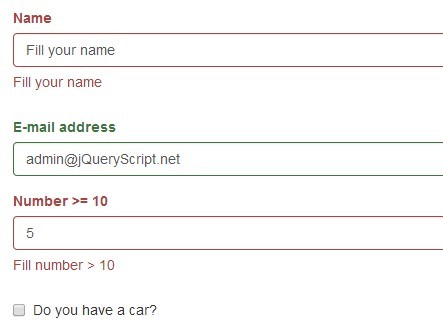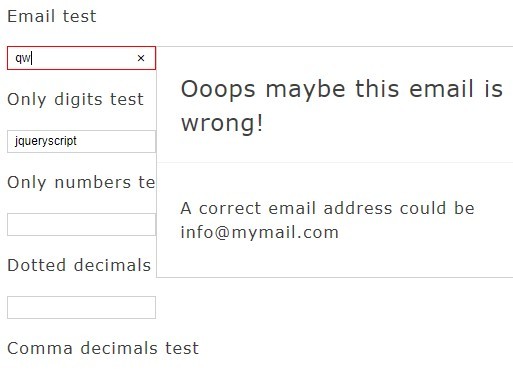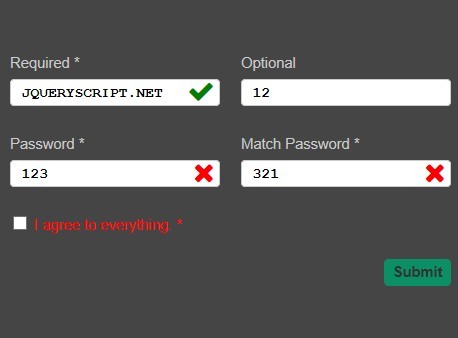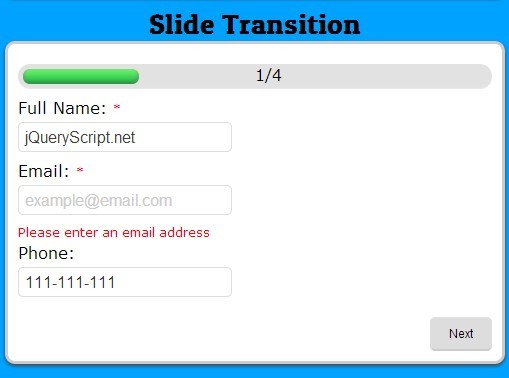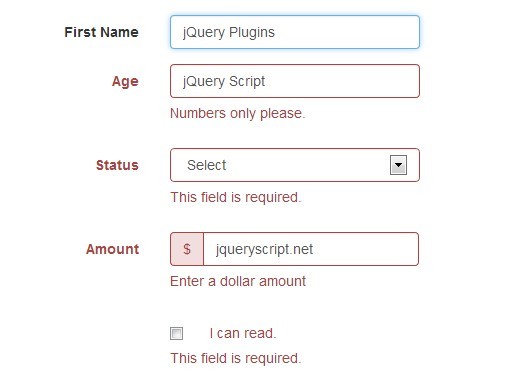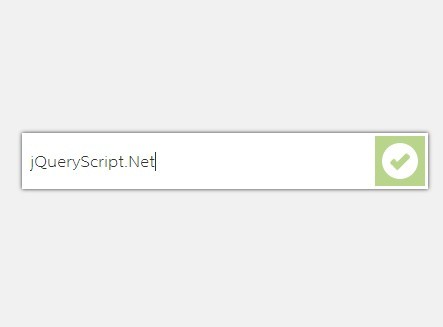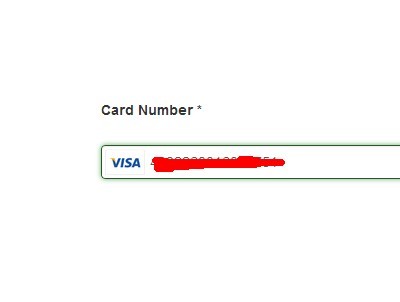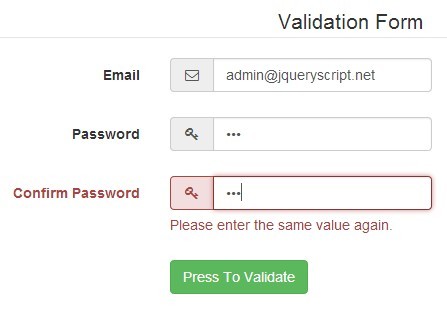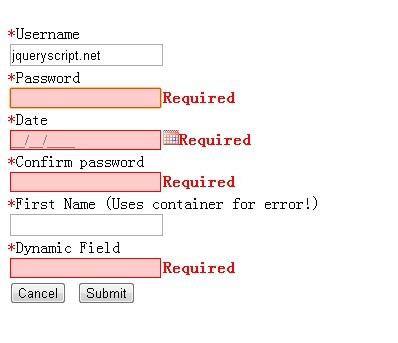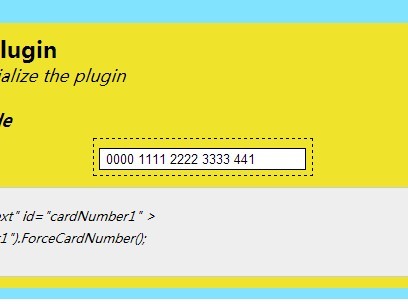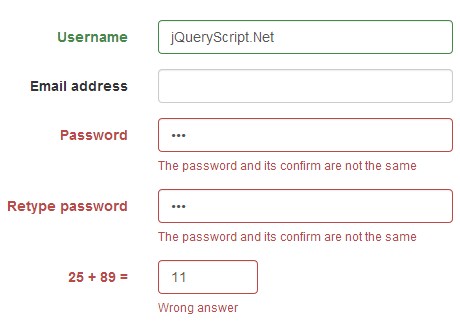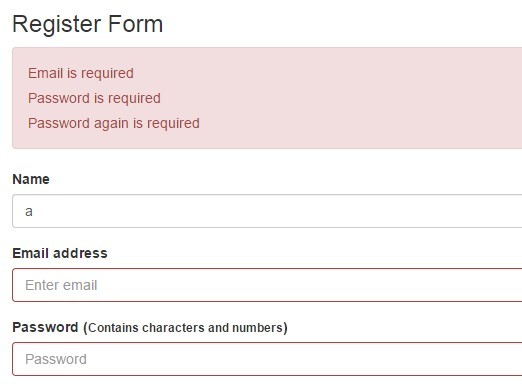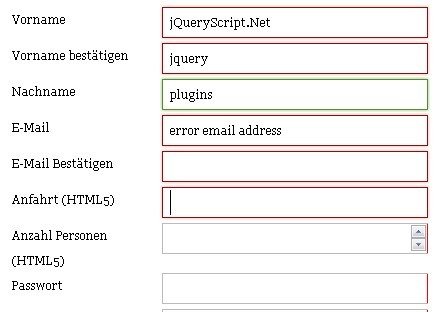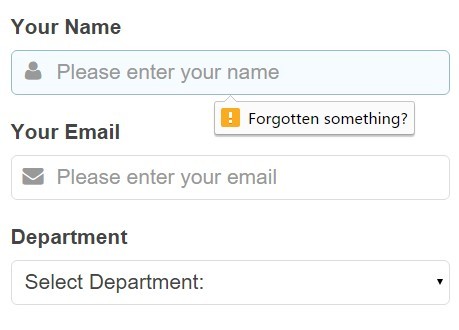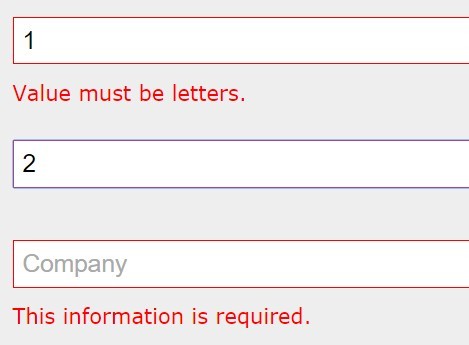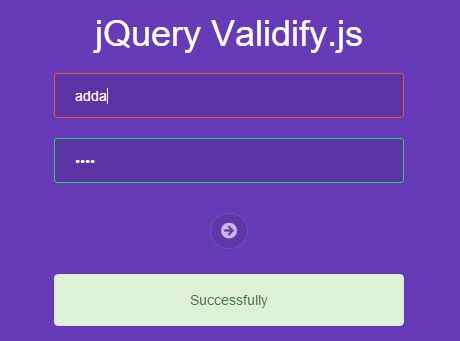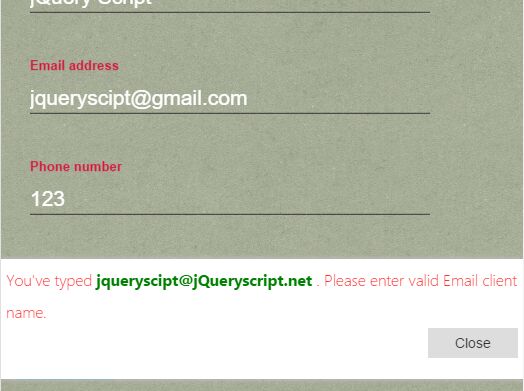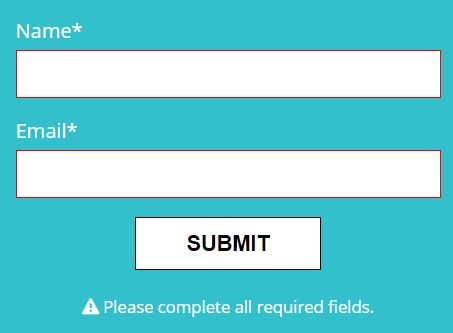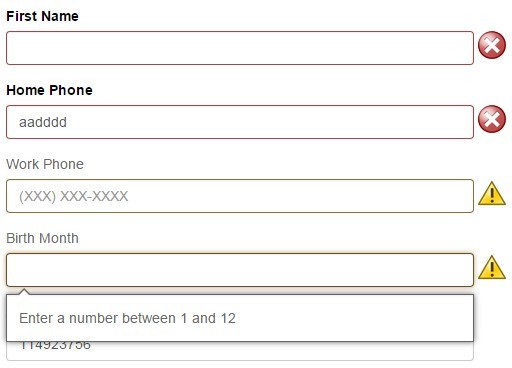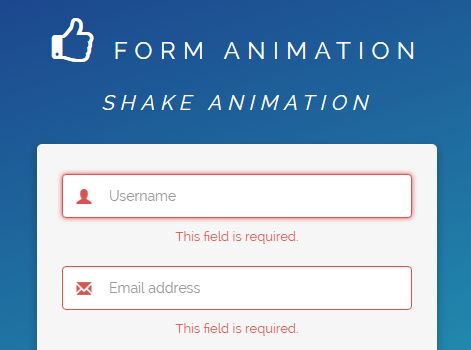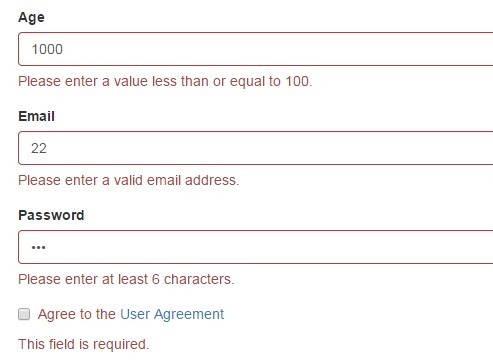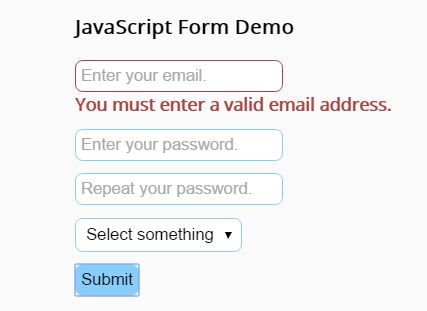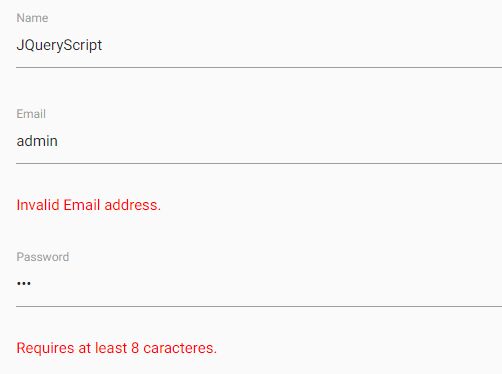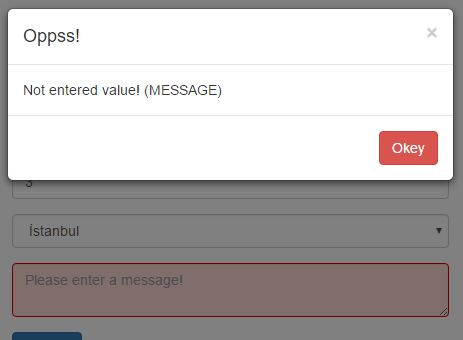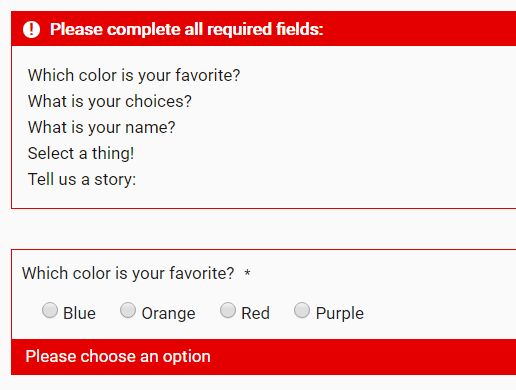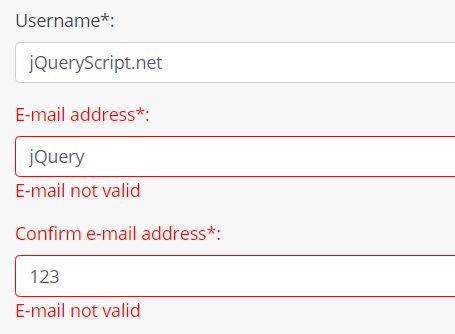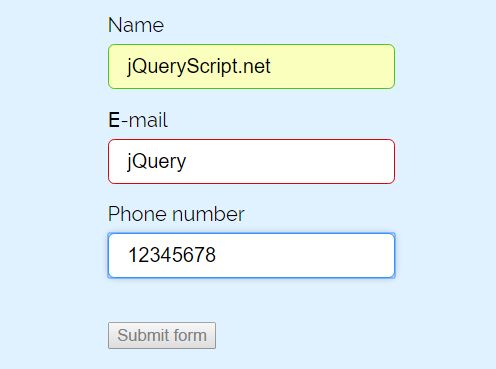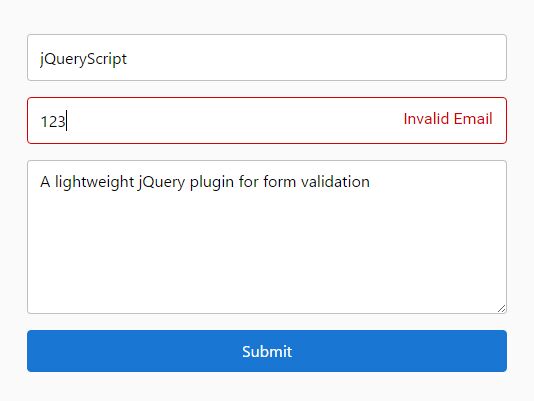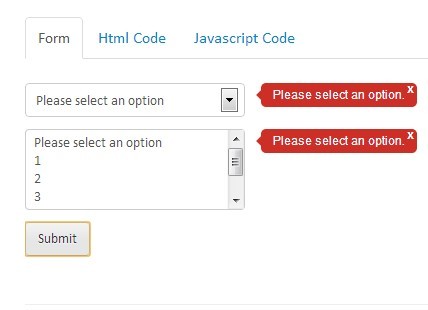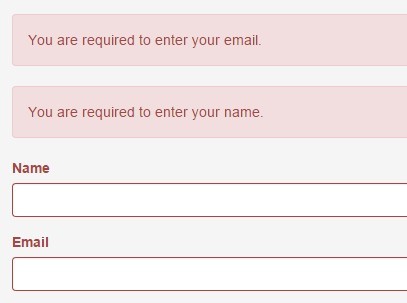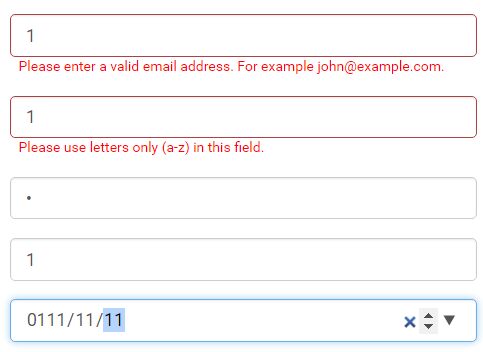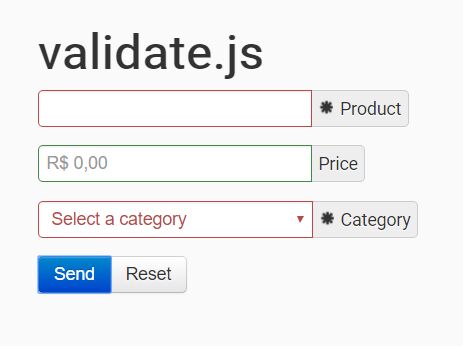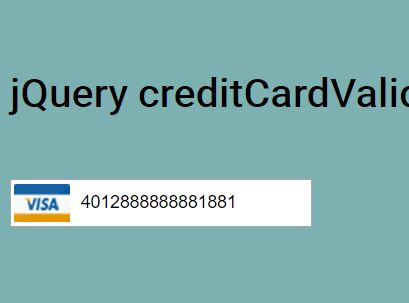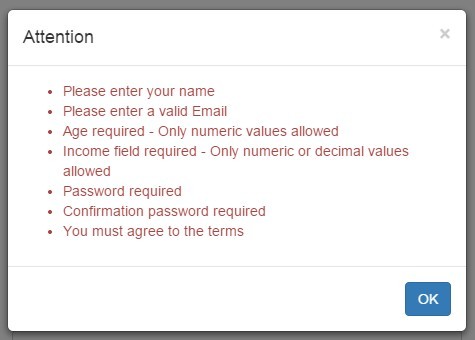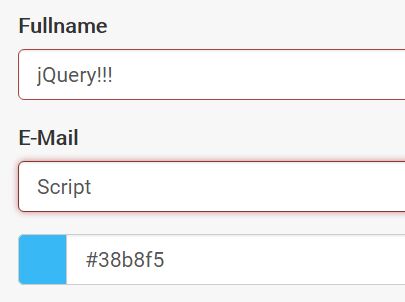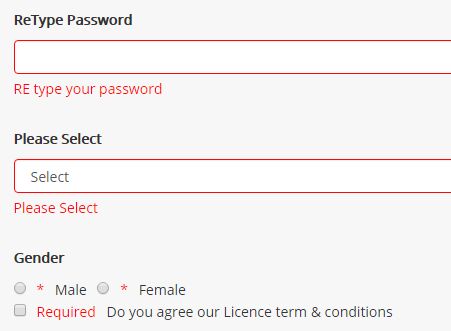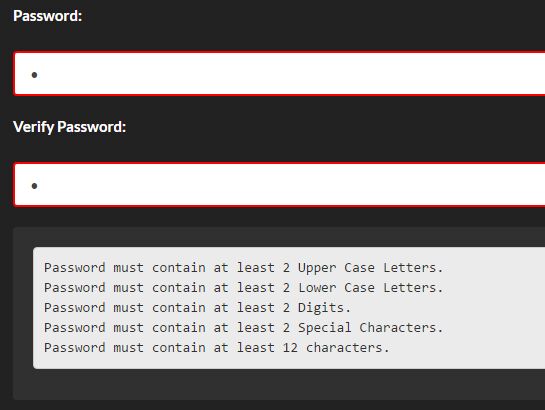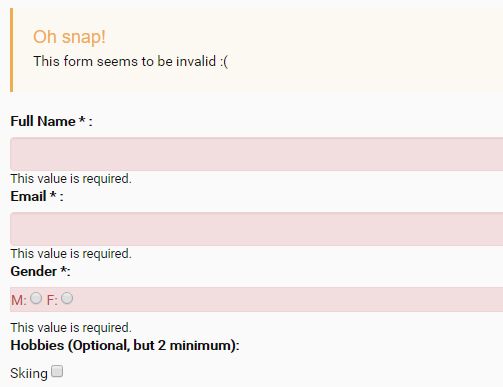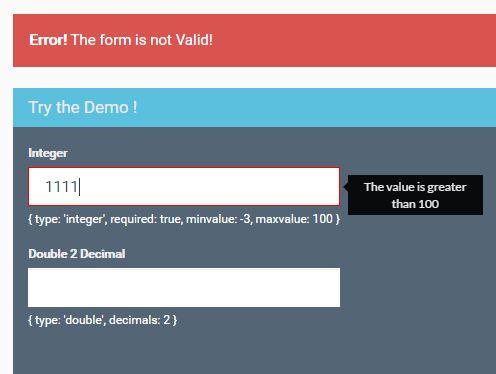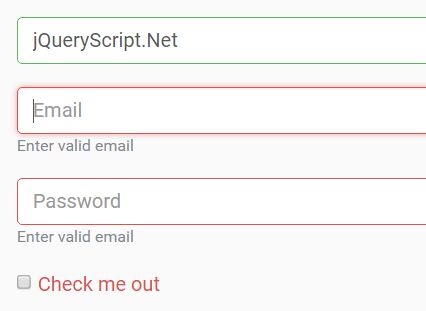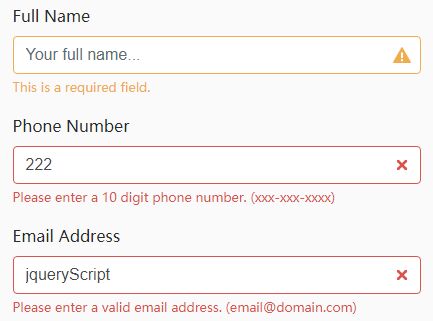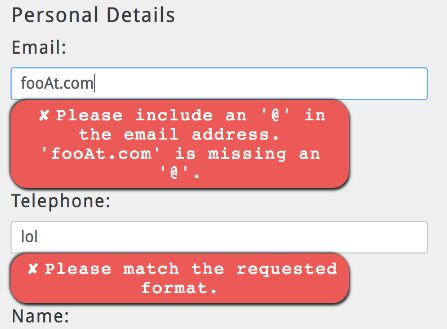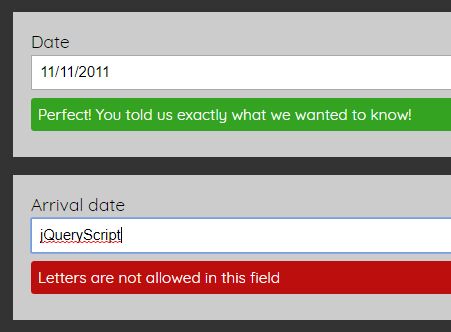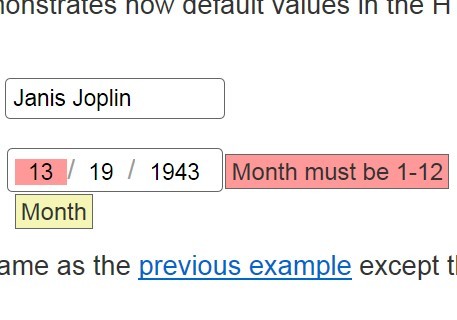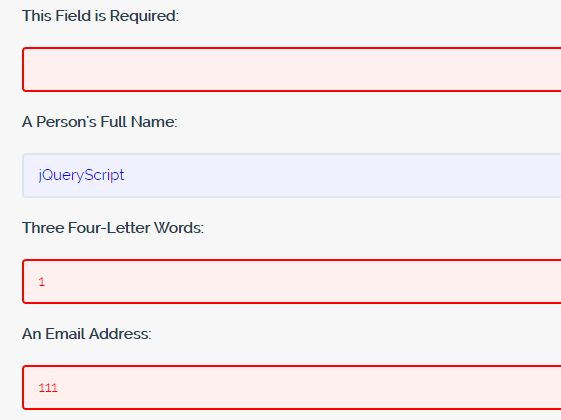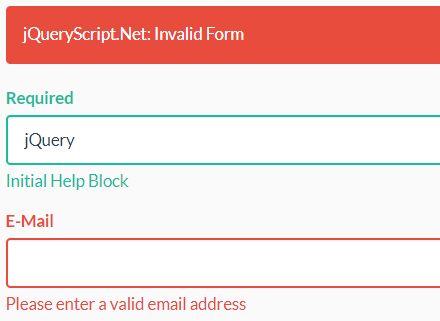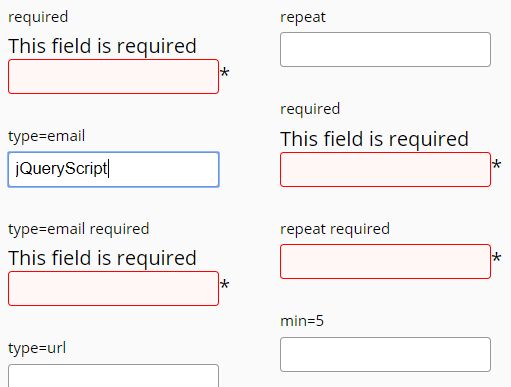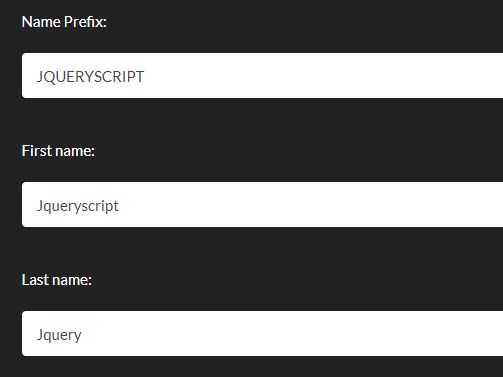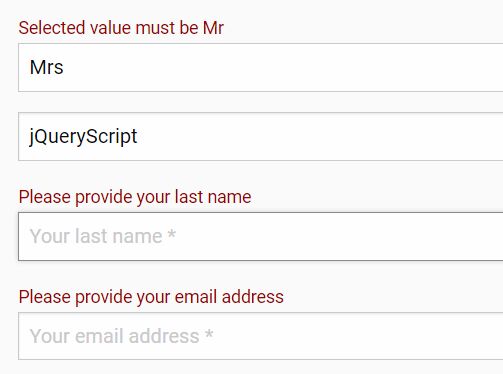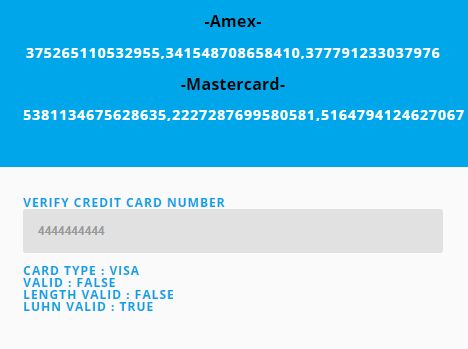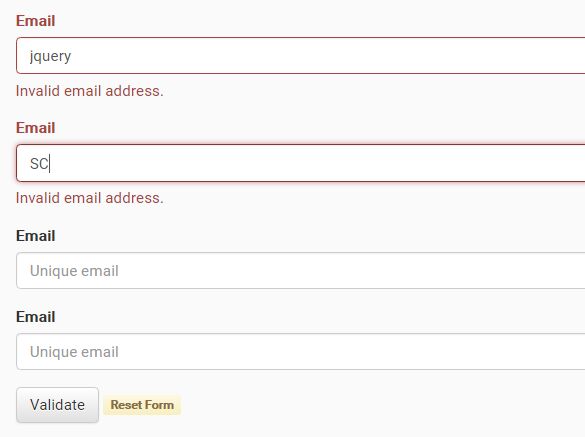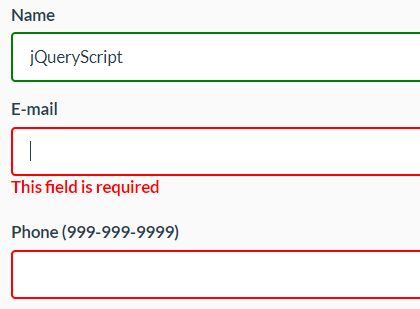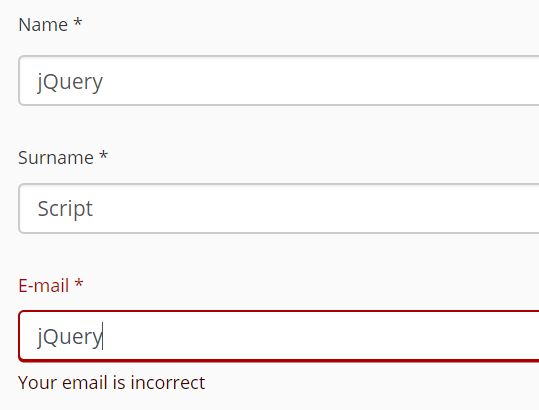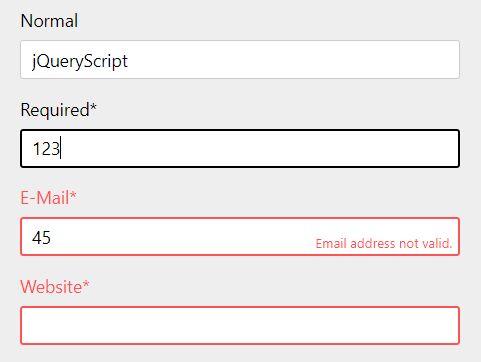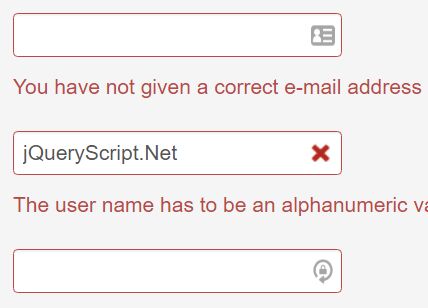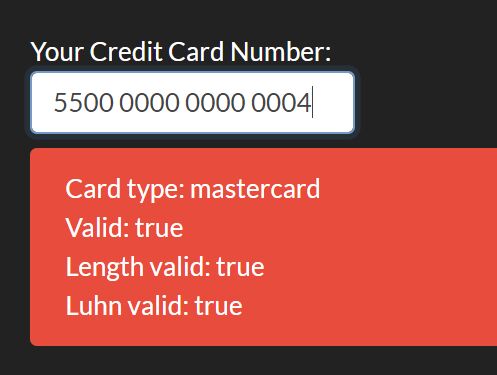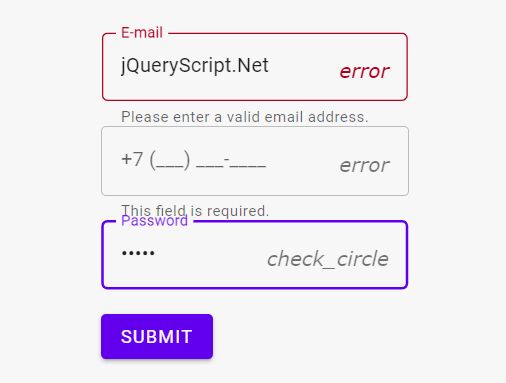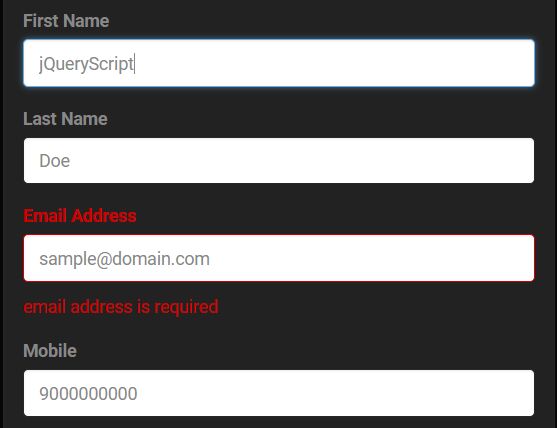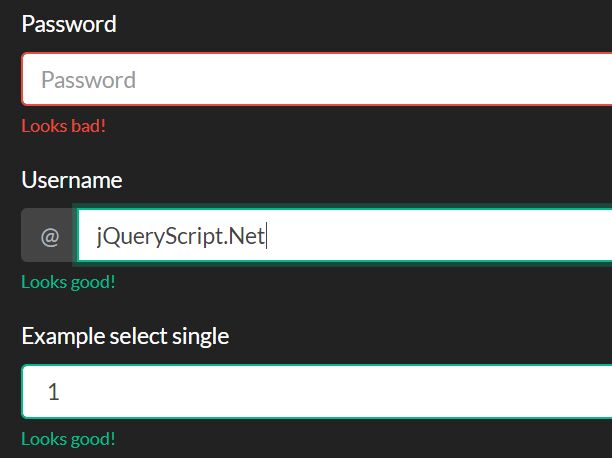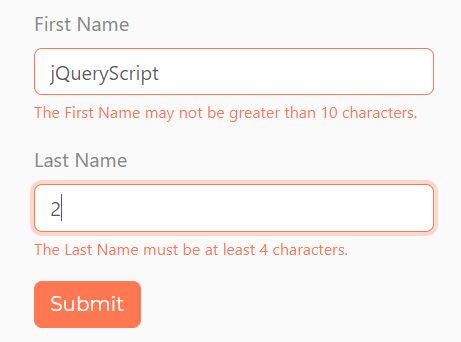jQuery-bValidator
jQuery form validator
Installation
Install via bower
bower install --save jquery-bvalidator Link library
<script src="bower_components/jquery-bvalidator/bvalidator.jquery.min.js"></script>Handling form
Init form:
$('form').bValidator(); Default options
errorClass: 'error', errorMessageClass: 'error-message', validClass: 'valid', rowClass: 'row', onFocusHideError: false // Hide error after focusing input onKeyUpValidate: false // If true, add extra on key up validation domType: 'row' // another option: 'direct'. Explained below onValid: function(form, element) {} // Function triggered after succesfully validated element onInvalid: function(form, element) {} // Function triggered after unsuccesfully validated element beforeSubmit: function(form, event) {} // Function triggered before submitting valid form onSubmitFail: function(form, event) {} // Function triggered after trying to submit invalid form onFocusIn: function(form, element) {} // Triggered after focusing element onFocusOut: function(form, element) {} // Triggered after focusing out of element onKeyUp: function(form, element) {} // Callback after pressing key when is input focused, only for onKeyUpValidate=trueInit form with all options:
$('form').bValidator({ errorClass: 'alert', errorMessageClass: 'alert-message', validClass: 'success', rowClass: 'form-controll', onFocusHideError: false, // no reason to allow in combination with onKeyUpValidate = true onKeyUpValidate: true, domType: 'direct', onValid: function(form, element) { console.log('Input with name ' + element.attr('name') + ' is valid'); }, onInvalid: function(form, element) { console.log('Input with name ' + element.attr('name') + ' is invalid'); }, onSubmitFail: function(form, event) { console.log('Some inputs are not valid'); }, beforeSubmit: function(form, event) { console.log('Validation success'); }, onFocusIn: function(form, element) { console.log('Input focused in'); }, onFocusOut: function(form, element) { console.log('Input focused out'); }, onKeyUp: function(form, element) { console.log('Key pressed over input'); } });Remove validations:
$('form').bValidator('destruct');HTML structure
You can choose html structure from two types (by domType option). In both cases, validation rules and other behavior are set by html data attributes.
Row structure
<form> <div class="row"> // this element can be span or any other <input type="text" data-bvStrict="rule"> <span class="error-message">Input is not valid</span> </div> <div class="row"> <input type="text" data-bvStrict="rule"> <span class="error-message">Input is not valid</span> </div> </form>If input is invalid, validator adds error class to a .row element. If input is valid, validator adds valid class to a .row element. You can name classes for error/valid messages by your desire, but remember to give it 'display: none' property and change it via rows .error/.valid classes. HTML structure doesn't have to be flat, you can wrap inputs and messages into another elements.
Direct structure
<form> <label for="input1">First input</label> <input type="text" name="input1" data-bvStrict="rule"> <span class="error-message error-input1">First Input is not valid</span> <label for="input2">Second input</label> <input type="text" name="input2" data-bvStrict="rule"> <span class="error-message error-input2">Second Input is not valid</span> </form>If input is invalid, validator adds error class to an input, input labels and error message associated by its name. If input is valid, validator adds valid class to an input, input labels and error message associated by its name. HTML structure doesn't have to be flat, you can wrap inputs, labels and messages into another elements. Validator searches for labels and error messages only inside form element.
Working with inputs
Setting validation rules
You can set custom validation rule by adding data-bvStrict attribute to the input.
Validate input as email
data-bvStrict="email"Validate input as czech phone number (9 digits)
data-bvStrict="phone"Validate input as number
data-bvStrict="number"Number > 1
data-bvStrict="number:1"Number < 10
data-bvStrict="number::10"Number between 1 and 10
data-bvStrict="number:1:10"Input can't be empty
data-bvStrict="notEmpty"Input has to be empty
data-bvStrict="empty"Input has to be string
data-bvStrict="string"Validate input as a date (wildcards allowed in format string: d, dd, m, mm, yy, yyyy. E.g. d/m/yy, d. m. yyyy, dd-mm-yyyy, yy, m, d)
data-bvStrict="date:format"Always invalid input
data-bvStrict="false"Always valid input
data-bvStrict="true"Checkbox has to be checked
data-bvStrict="checked"Validate input by regular expression
data-bvStrict="reg:^[\d]{2,3}$"If regular expression contains | or &, it has to be inside double brackets {{ }}
data-bvStrict="reg:{{^him|her$}}"Connected rules
Input has to have same value as input with name password
data-bvStrict="same:password"Conditions
If input with name service is valid by rule checked, rule validates input by rule email If service is not valid, rule returns true
data-bvStrict="if:service:checked:email"Adding regular expression rule. Whole rule has to be inside double brackets {{ }}, not just it's parameter
data-bvStrict="if:service:checked:{{reg:^him|her$}}" data-bvStrict="if:type:{{reg:^4$}}:email"If input with name service has value 4, rule validates input by rule email If service is not valid, rule returns true
data-bvStrict="ifv:service:4:email"This does the same as
data-bvStrict="if:service:{{reg:^4$}}:email"Combinating rules
Input has to be phone or email
data-bvStrict="phone|email"Input has to be empty or valid email
data-bvStrict="empty|email"Input has to be both string and number
data-bvStrict="string&number"Input has to be phone or ( string and number ). & has higher priority than |
data-bvStrict="phone|string&number"You can combine rules as you want
data-bvStrict="if:type:{{reg:^2$}}:email|if:type:{{reg:^4$}}:phone|same:password®:{{^[\d]{2,3}$}}"Other input attributes:
Add prefix to a value. It's removed before submitting form and after focusing input.
data-bvPrepend="\+420 "Add suffix to a value. It's removed before submitting form and after focusing input.
data-bvAppend=" kW"Placeholder. It's removed before submitting form and after focusing input.
data-bvSwitch="Fill name"Sets value to "@", if input is empty. It's removed before submitting form and after focusing input.
data-bvEmpty="@"Erasing spaces from value
data-bvTransform="noSpaces"Manually validate inputs:
$('inputs').bValidator('validate');Check if inputs are valid
Returns false if at least one is invalid, otherwise true. This method does not display errors.
$('inputs').bValidator('isValid');Validate with different rule
$('inputs').bValidator('isValid', Array('email'));Custom rules
jQuery.bValidator.validation('rule_name', function(value, args, elem) { return true/false; });Custom transformer
jQuery.bValidator.transformation('transformation_name', function(value) { return new_value; });